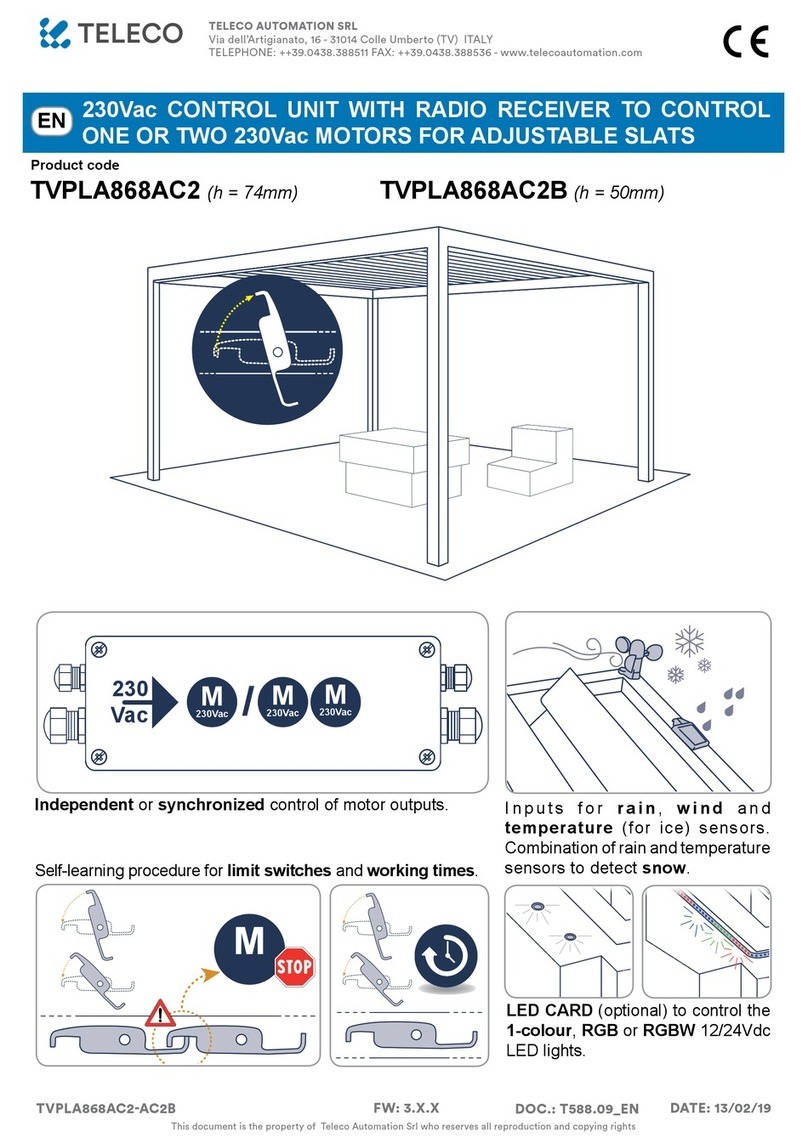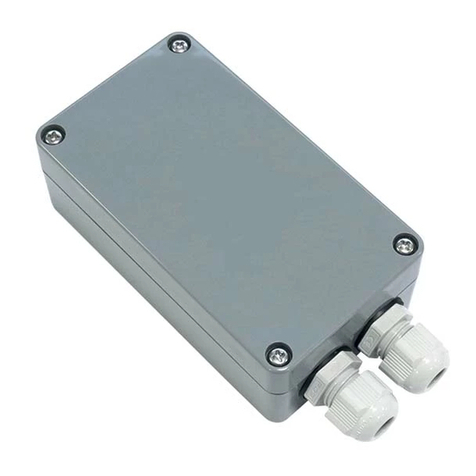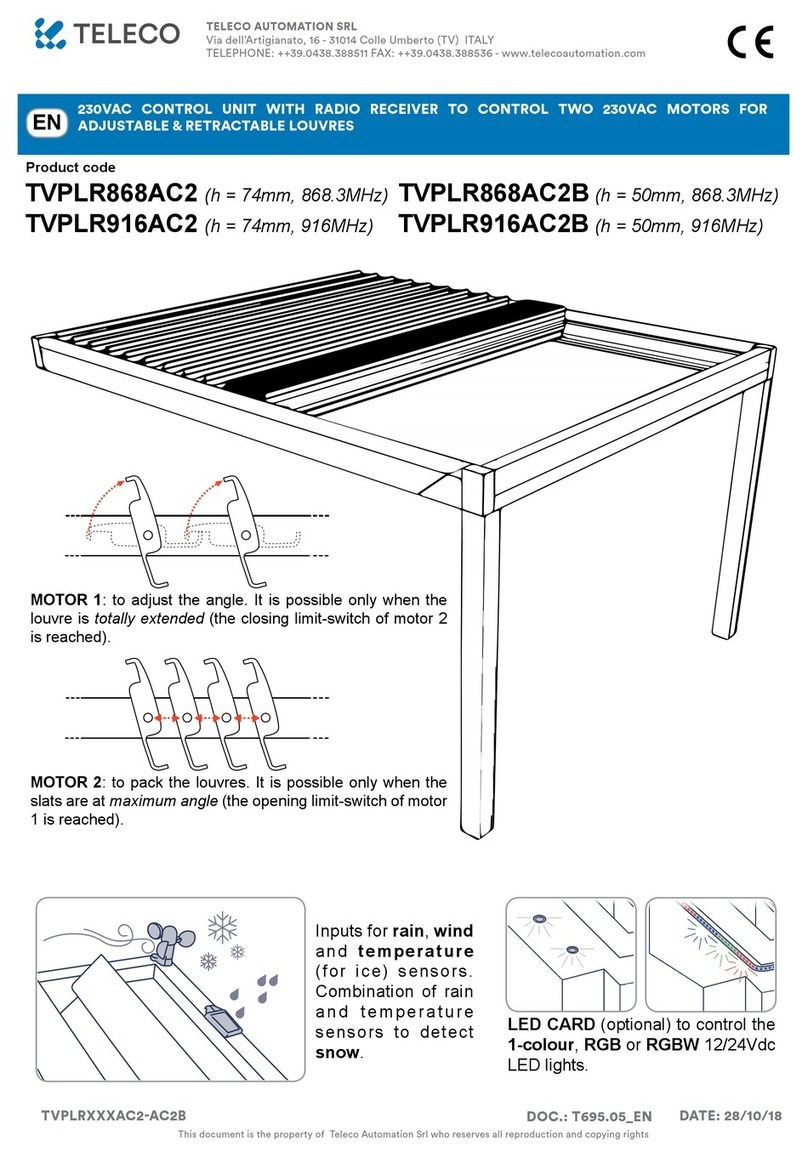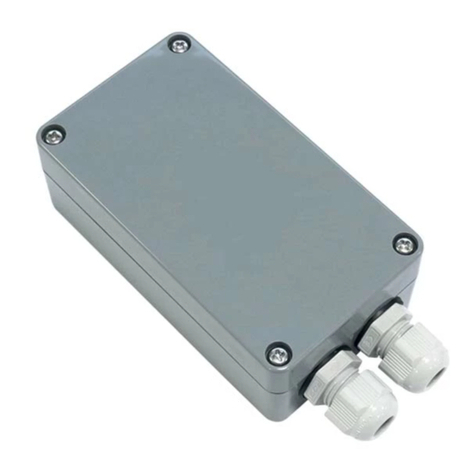
2
INDICE
1. Collegamenti e regolazioni p. 2
2. TRASMETTITORI p. 3 - 5
2.1 Memorizzazione codici radio
2.2 Congurazione del tempo lavoro (necessaria
se si usano trasmettitori 7/42 canali)
2.3 Cancellazione codici radio
2.4 Memorizzazione remota di ulteriori codici radio
2.5 Cancellazione remota di un codice radio
3. SENSORI p. 5
3.1 Sensore VENTO
3.2 Sensore PIOGGIA
4. Speciche tecniche p. 22
AVVERTENZE
Il prodotto in oggetto deve essere installato, messo in servizio e controllato periodicamente solo da personale tecnico qualicato nel
rispetto delle normative vigenti riguardanti le coperture automatiche. Tutti i collegamenti devono essere previsti per un’alimentazione
generale monofase 230Vac. Per la disconnessione dalla rete utilizzare un interruttore onnipolare con un’apertura dei contatti
di almeno 3,5 mm. Predisporre tutti i dispositivi di sicurezza necessari ed utilizzare materiali di collegamento idonei secondo le
attuali normative sulla sicurezza elettrica. I cavi di collegamento devono avere una sezione adeguata al carico applicato. Prima
di collegare l’alimentazione assicurarsi che i sensori e i motori siano collegati correttamente. Un errato collegamento (polarità
discordi) potrebbe danneggiare i motori oltre che gli elementi meccanici ad essi collegati. Si consiglia l’uso di un cavo 2x1.5mm
per collegare il motore al dispositivo per una lunghezza no a 6m, mentre è opportuno un cavo 2x2.5mm per tratte superiori.
SMALTIMENTO DEL PRODOTTO: alla ne della vita utile, l’apparecchio non deve essere smaltito come riuto domestico, ma
conferito in un centro di raccolta riuti elettrici ed elettronici. Con la presente Teleco Automation s.r.l. dichiara che il prodotto è
conforme ai requisiti essenziali, ed alle altre disposizioni pertinenti, stabilite dalla direttiva 1999/5/CE. La dichiarazione di conformità
può essere consultata sul sito: www.telecoautomation.com/ce. Nell’ottica di un continuo sviluppo dei propri prodotti, il produttore
si riserva il diritto di apportare modiche a dati tecnici e prestazioni senza preavviso.
1Collegamenti e regolazioni
DIP1 DIP2 (A)
OFF OFF 1
OFF ON 2
ON OFF 3
ON ON 4
Default
FINECORSA. La centrale è in grado di arrestare i motori in corrispondenza
di un fermo meccanico, per assorbimento di corrente. La soglia può essere
impostata con DIP1 e DIP2 (tabella). Attenzione! Controllare che il motore
si fermi solo in corrispondenza dei necorsa (LM = ON): aumentare la soglia
se il motore si ferma durante la manovra o diminuire se il motore continua a
spingere sui fermi meccanici. Solo nella
versione “TS”
IT
M
RN
LED
LR LA LM
8 9 10
DIP SWITCH P1
2
1
5
4
3
15
16
17
7
6
12
11
AN
LED
1MOTORE (CHIUDE)
2MOTORE (APRE)
3SENSORE PIOGGIA (GIALLO, GND)
4SENSORE PIOGGIA (BLU, SEGNALE)
5SENSORE PIOGGIA (BIANCO, +12V)
6SENSORE VENTO (BLU)
7SENSORE VENTO (MARRONE)
8COMUNE INGRESSI
9INGRESSO CHIUDE/STOP (N.A.)
10 INGRESSO APRE/STOP (N.A.)
11 ANTENNA RF
12 ANTENNA GND
15 ALIMENTAZIONE 230Vac (FASE)
16 ALIMENTAZIONE 230Vac (NEUTRO)
17 TERRA
AN LED IMPULSI SENSORE VENTO
RN LED SENSORE PIOGGIA ATTIVO
LA LAMPEGGIANTE = ALLARME VENTO
LR ACCESO = ALLARME PIOGGIA
LM LED FINECORSA
P1 TASTO DI PROGRAMMAZIONE



































